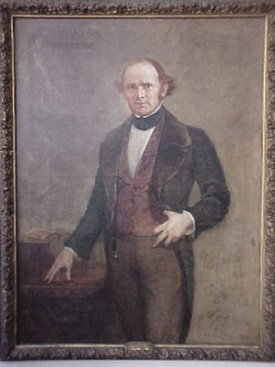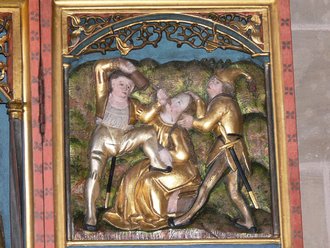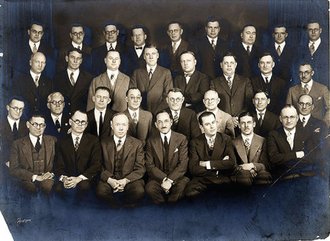chapter 41 The Controversial Development of Anesthesiology in Dentistry
The development of advanced pain control modalities in dentistry has never been without controversy, legal and otherwise, from both without and within the profession. Professional society, state regulatory agency, judicial, and individual files are well stocked with attorney-generated missives to cease and desist, allegations of antitrust conduct, accusations of defamation, and defensive replies about First Amendment rights and the truth as an absolute defense to defamation. In addition to the moral and ethical machinations such issues lead to, there is almost always a significant, generally not publicly addressed or argued, economic component affecting all individuals involved in the controversies. Everyone seems to have concerns about his or her piece of the pie when it gets right down to it. Such has been the state of affairs even since the very day dentistry gave safe, reproducible, anesthesia to the world, a bequest recently called one of the three greatest advances in modern medical history (i.e., since 1840) by the British Medical Association.1
Today, the vast majority of dental procedures are accomplished by means of the administration of local anesthesia, which has been in constant use in dentistry since William Stewart Halstead, a physician who understood perhaps better than most surgeons patients’ abhorrence to pain,2 began performing nerve conduction blocks in 1884.3,4 Halstead recruited Dr. Nash, a dentist, to care for an upper incisor after injection of cocaine near the infraorbital nerve at the infraorbital foramen. Halstead thereafter performed an inferior alveolar nerve block on a medical student volunteer.5 These two injections have evolved to more than 300 million dental local anesthesia administrations performed annually in the United States.6 Dentists likely administer more local injections per capita than any other health professional. Halstead’s introduction of nerve blocks to the profession was secondary to his melding of Alexander Wood’s 1855 use of the hollow needle7 and Carl Koller’s demonstration of the effectiveness of cocaine as a local anesthetic.8
HORACE WELLS AND WILLIAM T.G. MORTON
However, as popular and effective as local anesthesia is today in dentistry, our dental ancestors might be surprised that dentistry has drifted so far from other pain control techniques. Local anesthesia was indeed preceded by the development of sedation and general anesthesia by dentists. In 1844, Horace Wells (Figure 41-1) first publicly demonstrated the use of nitrous oxide for a surgical procedure at Massachusetts General Hospital.9 In 1846, dentist William T.G. Morton demonstrated the use of ether, also at Massachusetts General Hospital.10 In a short period of time, a controversy developed between Wells, Morton, and other individuals as to who should be given primary credit for the discovery of anesthesia.
In Morton’s case, it is ironic that credit for one of the most beneficent gifts to mankind was claimed by a classic, chronic scoundrel. That notices were published in Rochester, N.Y.11 and St Louis, Mo.12 warning the populace to “look out for” and “beware” of the “villain” Morton is not surprising. Morton’s legal and moral transgressions are numerous and well documented and include but are not limited to: embezzlement, excommunication from his church for profanity and dishonesty, passing bad checks, the theft of U.S. mail seals, forgery, abandoning fiancées, and even skipping out on medical bills.13
As far as Morton’s place in the history of anesthesiology, one of the earliest legal rulings concerning medical procedure patents was Morton v. New York Eye Infirmary, 17 E. Cas. 879 (C.C.S.D.N.Y. 1862). Dr. Morton sued the infirmary for infringing his patent for the use of ether for surgical procedures. The court determined that Morton’s patent was invalid because the use of diethyl ether during surgery was determined to be a discovery of a new use for a common chemical compound as opposed to an invention.14 Following this case, medical procedure patents were generally considered inappropriate, which may ultimately be Morton’s greatest contribution to patient health.
The issue of whom the honor of the initial development of anesthesia belonged grew to involve even the U.S. Congress15 and health professionals in Europe. Other authors16 have pointed out that for millennia mankind has attempted to reproduce the biblical account of Adam’s “deep sleep”17 to reduce pain during surgery. However, until Wells, who had completed less than 15 nitrous oxide cases before his appearance at Massachusetts General Hospital, no one had publicly reported a safe and predictably reproducible pain control technique for surgical procedures. Ultimately, it seems that Wells likely has prevailed in the primacy argument, as he is recognized by the lay public and the professions in the United States18–27 and Europe.28
Specifically, in 1864 The American Dental Association (ADA) adopted the resolution that “… to Horace Wells, of Hartford, Connecticut, (now deceased) belongs the credit and honor of the introduction of anesthesia in the United States of America, and we do firmly protest against the injustice done to truth and the memory of Dr. Horace Wells, in the effort made during a series of years and especially at the last session of Congress, to award the credit to other persons or person.”29 This resolution was reaffirmed in 1872.30 In 1870 the American Medical Association (AMA) resolved that “…the honor of the discovery of practical anesthesia is due to the late Dr. Horace Wells, of Connecticut.”31
As strange as it may seem, the development of pain control techniques for surgical procedures was in and of itself somewhat controversial. Until Wells’ demonstration, the attitude of surgeons worldwide can be summed up by French surgeon Alfred Louis Marie Velpeau’s 1839 statement that “To escape pain in surgical operations is a chimera which we are not permitted to look for in our days. A cutting instrument and pain in operative medicine are two ideas which never present themselves separately to the mind of the patient, and it is necessary for us surgeons to admit their association.”32
Historically, dental procedures were one of the most common examples of a singularly excruciating (Latin “of the cross”) surgical pain experience, as exemplified by the patron saint of dentistry, Apollonia (Figure 41-2), who was immolated in third century Alexandria only after undergoing torture (Latin “to twist”) involving dental and facial fractures. The trend emphasizing the pain of dentistry is continued in the popular culture today, for instance in movies such as Little Shop of Horrors, Marathon Man, and The Dentist.
EARLY RESISTANCE TO ANESTHESIA
Anesthesia controversy has not been limited to internecine conflicts within the health professions. Once anesthesia was quickly adopted by medicine, it was denounced not only by some surgeons, but even from the pulpit. It is understandable that surgeons would decry the use of anesthesia, particularly when it was not readily available to all surgeons, some of whom witnessed their patients gravitating to competitors who could offer the administration of anesthesia. In 1859 a physician at a public meeting opined that “Pain is the wise provision of nature, and patients ought to suffer pain while their surgeon is operating; they are all the better for it, and recover better.”33
In opining that anesthesia was somehow immoral and the diminution of pain an unnecessary truncation of “God’s will,”34 preachers often ignored Adam’s “deep sleep” and instead quoted Genesis 3 : 16: “Unto the woman he said, I will greatly multiply thy sorrow and thy conception; in sorrow thou shalt bring forth children …”35 James Simpson, a physician of Edinburgh, Scotland, and an early European advocate of inhalational anesthesia, received a letter from a preacher stating that ether anesthesia was a “decoy of Satan” and that it would “rob God of the deep earnest cries which arise in time of trouble …”36 As late as 1929, H.W. Haggard opined that “the very suffering which a woman undergoes in labor is one of the strongest elements in the love she bears for her offspring!”37 Circumspectly the author’s spouse asked if there are any similar quotes regarding the use of anesthesia in childbirth from women.38
During these years, religion often entered into public controversies. Organized dentistry was not shy about speaking to, for instance, both sides of the debates about Darwinian theories of the origin of species. In 1873, American Dental Convention President I.J. Wetherbee devoted his annual session opening address to the criticism of Darwin’s work.39 Dental Cosmos editor J.H. McQuillen had previously published: “Whenever a new and startling fact is brought to light in science, people first say, ‘it is not true’; then, that ‘it is contrary to religion’ and lastly, ‘that everybody knew it before.’”40
In spite of dental scriptures, such as Psalms 3 : 7: “… thou hast smitten all mine enemies upon the cheek bone; thou hast broken the teeth of the ungodly,”41 it is problematic that the use of anesthesia in dentistry was harshly criticized by some in organized dentistry. At the very least, not everyone with a broken tooth is likely ungodly. The American Society of Dental Surgeons (ASDS) stated: “… in all minor operations in surgery, (anesthetic) administration is forbidden; and that (the) demand in the practice of dental surgery is small …”42 The ASDS, the first national dental organization, was only in existence from 1840 to 1856. However, the ultimate demise of the ASDS was primarily caused by the amalgam controversy. The ASDS first fought against the use of amalgam and sought to enforce its views primarily by legislative fiat rather than scientific study, but ultimately rescinded its amalgam policy, disgusting many members in addition to historical antagonists.43
In addition to criticism of anesthesia from the quarters mentioned, surgical procedures were considered as a last resort, after all else in medicine had failed. Reminiscent of the medical science fiction in television and motion picture versions of Star Trek, the Dr. McCoy-like working theory in the first decades of the nineteenth century was that the true triumph of medicine would result in the obsolescence of surgery.44
PROFESSIONAL LITERATURE, THE DENTAL COSMOS
Dentist Charles Teter argued for the preeminence of nitrous oxid [sic] as the agent of choice for dental procedures, stating: “I am sure that in the judgment of the thoughtful, experienced man there can be no favorable comparison” (with nitrous oxide with any other agent). Of course, techniques of nitrous oxide administration differed somewhat from those recommended today. Dr. Teter advised that “this gas must be given at least 80 per cent pure” (oxygen could be added for longer cases). Dr. Teter also supplemented his nitrous oxide with the “intelligent use of pre-anesthesia narcotics, such as morphin [sic], atropin [sic], and scopolamin [sic].” Confidently “… the accomplished dentist can keep his patient under the anesthetic as long as may be necessary to complete his work … I almost consider it an insult to my intelligence and skill when a patient or physician makes the remark, ‘Doctor, I would like so many teeth extracted, but if you can’t get them all, I wish you would remove certain ones,’ etc. I think this is disgraceful and a stigma on the profession. If the dentist is not capable of anesthetizing his patient and keeping him anesthetized to the completion of this work, he should send his patients to one more competent.” Prophetically, Dr. Teter admonished that “There is an increasing demand for general anesthetics in dental surgery,” and “The time is soon coming in this country when there will be laws passed to restrict the administration of anesthetics, and it behooves the dental profession to see that the subject is given a prominent place in the curriculum of our colleges … Unless this is done, the dental profession will be greatly humiliated by having the right to administer anesthetics annulled.”45
Volume 53 also held an article by Dr. Guido Fischer of the University of Greifswald, Germany who argued for the use of local anesthesia in dentistry. Dr. Fischer proposed: “The efforts of modern medicine are more and more concentrated upon an endeavor to limit general anesthetics as much as possible, and to have local anesthetics take their place, by the endeavor to develop these to the highest perfection. I need only refer to the introduction of the anesthesia of the medulla by Bier …” He noted that organic agents “… can produce fatty metamorphosis of the inner organism” and that with ether narcoses, one sees death once in every 3000 or 4000 cases. Paradoxically, Dr. Fisher opined: “In dentistry local anesthetics should be the only kind used, and one should resort to general anesthetics only in exceptional cases.” Although Dr. Fischer never defines “exceptional,” he does admit that “obstinate or timid” patients may need to be narcotized with ether or ethyl bromid [sic]. Also: “There is one inconvenience which still attaches to cocain, viz, its often very toxic influence on the living tissues.” Toxic effects besides death “often observed” from the “smallest dose” include rapid pulse, difficult respiration, nervous excitement, nausea, vomiting, convulsions, dyspnea, and collapse.46
Finally, one last reference from volume 54 is titled “Stimulants in Cases of Heart Failure Due to Cocaine.” This clinical tip was offered: “In view of the almost universal use of cocaine and the fact that owing to idiosyncrasies even its use topically sometimes brings about alarming symptoms, we should be especially prepared to meet conditions of heart failure.” The author’s generally employed prescription for heart failure is a mixture of ether, camphor, and olive oil, but if that or “everything else fails,” he recommended 1911 advanced cardiac life support (ACLS) of “artificial respiration, about twenty beats to the minute.”47
Predictably, patients, whether they studied the arguments in the professional literature or not, when given the option of having anesthesia or not availed themselves of anesthesia for even minor48 surgical procedures when possible. Patients did so despite the condemnation of anesthesia by professional society spokespersons after controversial dental entrepreneurs, such as Gardner Q. Colton49,50 and Edgar R.R. “Painless” Parker (Figure 41-3),51 popularized techniques other than local anesthesia only. Parker believed that patients avoided dentistry because of pain, ignorance, procrastination, and lack of money, and of these, fear was the strongest deterrent.52 Working with a local druggist, Parker developed hydrocaine, an analgesic that contained cocaine. He aggressively advertised his services, reportedly removed 357 teeth in 1 day on a vaudeville stage, and coincidentally developed 30 West Coast dental offices that grossed more than $3 million annually in the early twentieth century. Not surprisingly the profession gradually began to embrace anesthesia not only as a morally acceptable form of therapy, but also one that would attract patients.
VARIED ANESTHESIA PROVIDERS
At the turn of the century, anesthesia in the United States was administered by dentists, physician general practitioners, surgeons, interns, medical students, nurses, orderlies, and often whoever was handy. In October 1905, a small group of nine physician-anesthetists met and formed the Long Island Society of Anesthetists, the precursor of the American Society of Anesthetists (1936) and ultimately, in 1945, the American Society of Anesthesiologists (ASA).53 Today, the ASA limits its membership to licensed physicians and osteopaths.
The International Anesthesia Research Society (IARS), the premier group of anesthesia providers in the world, was formed in 1922 to foster progress and research in all phases of anesthesia and is the publisher of Anesthesia & Analgesia. Based in Cleveland, OH, the 15,000 member IARS is nonpolitical and accepts as full members all doctorate level anesthesia providers, including dentists.54
Anesthesiology became a specialty of medicine in 1938 and of veterinary medicine in 1975.55 Anesthesiology has been a specialty in dentistry in Japan since 1973,56 in Ontario, Canada, and is the nation’s oldest nursing specialty, dating back to the Civil War.57 Medical and veterinary anesthesiologists and dental anesthesiologists in Japan are, of course, recognized as the most knowledgeable experts in their fields of surgical pain control. Local anesthesia is also commonly used by specialists, and most surgical procedures can be performed with local anesthesia only.58–60 However, not surprisingly, patients not only often believe that they need but also demand sedation or unconsciousness from these practitioners.
ORAL AND MAXILLOFACIAL SURGERY ANESTHESIA PIONEERS
As an example, consider the pioneering efforts of University of Southern California Dental School graduate Adrian Orr Hubbell (Figure 41-4). In 1937, Dr. Hubbell started a postdoctoral course of training that would include 2 years of surgery and an additional year of general anesthesia. Hubbell experimented with sodium thiopental and found it to be a wonderfully appropriate drug for oral surgery that had advantages over techniques such as 100% nitrous oxide.61 At this time, a prevailing attitude in medicine was shared t/>
Stay updated, free dental videos. Join our Telegram channel

VIDEdental - Online dental courses





